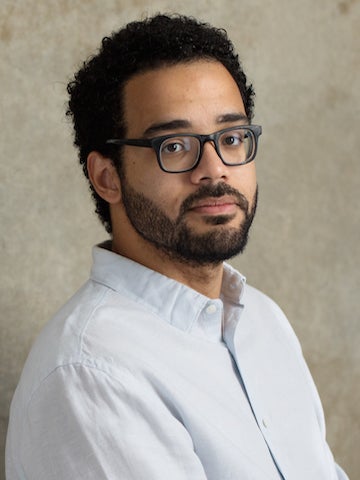Oberlin Center for Convergence (StudiOC)
Latin American Rhythms

Photo credit: Tanya Rosen-Jones ’97
Alysia Ramos

Photo credit: Tanya Rosen-Jones ’97
Kathryn Metz

Photo credit: Jennifer Manna
Sergio Gutiérrez Negrón
Latin American Rhythms
Offered Spring 2025
This course cluster, Latin American Rhythms, engages with Latin American Cultural production and cultural politics through the study of Latin American music and dance. It encompasses a new course in the dance department (DANC 150: Baila, Baila, Baila: Dancing Latin America) that will introduce students to the physical practice of various dance styles, complemented by readings, video viewings, and discussions aimed at understanding their cultural context. It will also include a modified version of the existing course in Hispanic Studies (HISP 350: Qué Flow: Music, Culture, and Politics in Latin America), a survey of the main trends in 20th and 21st-century Latin American popular music. Comparative American Studies (CAST 226: Music of the Americas) will help contextualize popular music across the Americas in comparative contexts. Delving into influential themes, including cultural appropriation, translation, and social media. Students participating in the StudiOC learning community must take at least two classes. However, each class will also have space for students outside the cluster. All courses will meet together on Fridays.
Instructors
Course instructors for this learning community are:
- Associate Professor and Chair of Dance: Alysia Ramos.
- Director of Musical Studies, Mellon Mays Undergraduate Fellowship Administrative Coordinator, and Senior Lecturer: Kathryn Metz.
- Director of the Lemle Center and Irvin E Houck Associate Professor of Hispanic Studies: Sergio Gutiérrez Negrón.
Courses associated with this cluster
Alysia Ramos, Instructor
DANC 150 OC: Baila Baila Baila: Dancing Latin(o) America
Meets 2:30 pm; Tuesday and Thursday, 4 Credit Hours, Enrollment 15
This course provides an exploration of popular Latin social dances, approaching them as rich sites of cultural negotiation, contestation, and exchange. Emphasizing dances that transcend their regional or national origins, such as salsa, bachata, reggaeton, favela funk, and others, the course examines how these art forms transform into influential global representations of Latinidad and forge a shared sense of pan-Latino cultural identity. Through a diverse set of analytical approaches, including movement practice, reading, writing, and discussion, participants will examine how dance can be a powerful lens for examining the intricate interplay between movement, culture, and socio-political dynamics within the context of Latin(o) America.
Taught in English. This course must be taken with either HISP 350OC or CAST 226OC.
Kathryn Metz, Instructor
CAST 226 OC: Music of the Americas
Meets 2:30 pm; Fridays, 4 Credit Hours, Enrollment 15
This course focuses on the flow of music across geopolitical and cultural borders, with emphasis on theories of cosmopolitanism, appropriation, circulation, and reception. In this class, students explore musical styles as they change in response to global and technological forces. Additionally, students explore the ways that musicians adapt to and challenge the dynamism of globalization, finding outlets in diasporic communities as inequitable political systems affect cultural creativity. Students will listen to and investigate musical styles and communities that straddle borders, including corridos, Nortec, mariachi, cumbia, salsa, and more.
This course must be taken with DANC 150OC.
Sergio Gutiérrez Negrón, Instructor
HISP 350 OC: Music, Culture, & Politics
Meets 2:30 pm; Monday, Wednesday, Friday, 4 Credit Hours, Enrollment 15
This course offers a survey of the main trends in 20th- and 21st-century Latin American popular music through an engagement with its cultural and political life. We will study the sexual politics of the bolero (Daniel Santos, La Lupe, Luis Miguel), the relationship between nueva trova (new folk) and the revolutionary politics of the mid-20th century (Silvio Rodríguez, Mercedes Sosa), the diasporic origin of salsa (Celia Cruz, Héctor Lavoe), the emergence and commercialization of "rock en español" (Soda Stereo, Cafe Tauba, Aterciopelados), the politics of the "Latin Explosion" of 1999 that offered the "crossover" as global trope (Ricky Martin, Shakira), the emergence of reggaetón (Daddy Yankee, Ivy Queen, Tego Calderón), the recent return to folklore and roots (Natalia Lafourcade), and the linguistic politics of contemporary trap (Bad Bunny, J Balvin). Taught in Spanish. This course offers a survey of the main trends in 20th- and 21st-century Latin American popular music through an engagement with its cultural and political life. We will study the sexual politics of the bolero (Daniel Santos, La Lupe, Luis Miguel), the relationship between nueva trova (new folk) and the revolutionary politics of the mid-20th century (Silvio Rodríguez, Mercedes Sosa), the diasporic origin of salsa (Celia Cruz, Héctor Lavoe), the emergence and commercialization of "rock en español" (Soda Stereo, Cafe Tauba, Aterciopelados), the politics of the "Latin Explosion" of 1999 that offered the "crossover" as global trope (Ricky Martin, Shakira), the emergence of reggaetón (Daddy Yankee, Ivy Queen, Tego Calderón), the recent return to folklore and roots (Natalia Lafourcade), and the linguistic politics of contemporary trap (Bad Bunny, J Balvin).
Taught in Spanish. This course must be taken with DANC 150OC. Prerequisite(s): HISP 304.